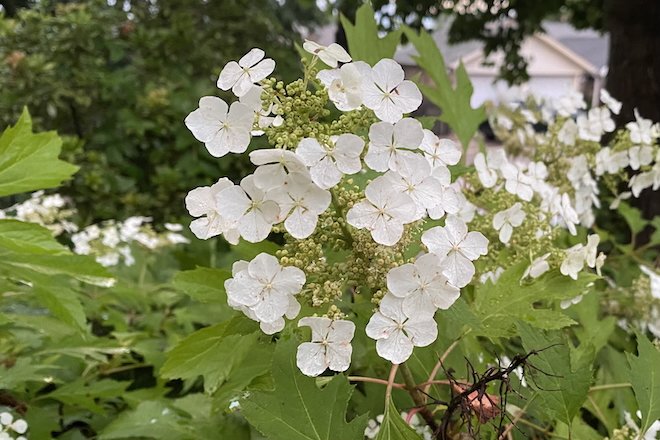This week: Sun-Loving Native Hydrangeas
Hello!
Do you love hydrangeas but feel torn because you want more natives in your landscape? It's a good thing there are a few native hydrangeas you can try!
First, let’s clear up which ones are not native: Hydrangea macrophylla (often branded Endless Summer) and Hydrangea paniculata (of which ‘Limelight’ is a cultivar). These originate from Asia and are some of the most ubiquitous flowering shrubs in landscapes and garden centers. If you look past these non-natives, you’ll often spot two hydrangeas native to the Eastern U.S.—H. quercifolia and H. arborescens.
Oakleaf Hydrangea

Hydrangea quercifolia is called Oakleaf Hydrangea because its foliage resembles oak leaves (the translated Latin name is “oak foliage”). In addition to its fetching foliage and flowers, the leaves change color in the fall to red or purple. In the winter, it shows off exfoliating bark—a true plant for all seasons. An advantage to this Hydrangea is it can handle full sun in addition to partial shade. In contrast, most non-native Hydrangeas are shade lovers that wilt in the sun. The straight species grows to 10 feet tall and wide. ‘Ruby Slippers’ and ‘Ice Crystal’ are a few compact cultivars that keep under five feet tall.
Oakleaf Hydrangea is native to the Southeastern U.S., so it should remain hardy as the climate shifts. If you're aiming for a Northeastern native hydrangea, you’ll want Smooth Hydrangea (Hydrangea arborescens) instead.
Smooth Hydrangea

Smooth Hydrangea is native to the Mid-Atlantic and is very cold-hardy (think northern Maine). It also tolerates full sun and shade, like the Oakleaf Hydrangea. The straight species is also smaller, only reaching around six feet tall. The flowers are usually white, and in the fall, it has yellow fall foliage. Smooth Hydrangea is also a larval host plant for the hydrangea sphinx moth. Common cultivars are 'Annabelle' and 'Incrediball,' and even some pink-hued variations are available.
A Note About Hydrangea Cultivars as Pollinator Plants
Hydrangeas have a mix of sterile and fertile flowers. The sterile flowers are large and showy, and the fertile flowers, while pretty, are more subtle. Many hydrangea cultivars are bred to have more sterile flowers than fertile flowers, and more sterile flowers mean fewer pollen sources for beneficial insects. If you have space for a straight species native, choose it over a cultivar. If you don’t, all is not lost: there are still some fertile flowers—just not as many as possible.
Elsewhere:
There’s still time to participate in Homegrown National Park’s online auction fundraiser! So far, it has raised nearly $30,000—check it out before bidding ends on Tuesday, March 11.
Have a great week,
Julie